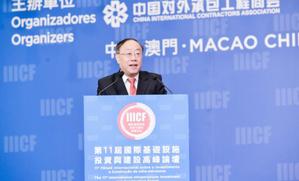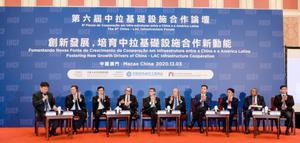 The 6th China-LAC Infrastructure Forum opens in the Macao Special Administrative Region on Dec 2, 2020, drawing ambassadors or representatives from 15 Latin America and Caribbean nations among other guests and speakers. (PHOTO / CHINA DAILY)
The 6th China-LAC Infrastructure Forum opens in the Macao Special Administrative Region on Dec 2, 2020, drawing ambassadors or representatives from 15 Latin America and Caribbean nations among other guests and speakers. (PHOTO / CHINA DAILY)
New energy and digital infrastructure will make for promising directions for Chinese enterprises’ infrastructure investment and construction in Latin American and Caribbean countries, experts said during the 6th China-LAC Infrastructure Forum, held in the Macao Special Administrative Region on Dec 2-3.
“Latin American and Caribbean nations are in big need of infrastructure,” Uruguayan ambassador to China Juan Fernando Lugris Rodriguez said at a press conference on Thursday. “Sustainable development requires very good infrastructure.”
In his address to the forum in Macao on Wednesday, Wang Bingnan, vice-minister of commerce, called on different sides to come together “brotherly” as an Argentine saying goes, to overcome difficulties and upgrade infrastructure and connectivity across the regions
Therefore the region welcomes innovative financing to support local infrastructure development, he said, stressing only through closer cooperation can we overcome various new challenges.
In his address to the forum in Macao on Wednesday, Wang Bingnan, vice-minister of commerce, called on different sides to come together “brotherly” as an Argentine saying goes, to overcome difficulties and upgrade infrastructure and connectivity across the regions, noting such fields as medical care, digital economy, modern logistics, new energy cultivation.
The forum, held with a dozen other events at the two-day 11th International Infrastructure Investment and Construction Forum (IIICF), drew ambassadors or representatives from 15 countries of the region to China and around 600 delegates during two days.
Wang noted the forum bears particular significance as it has become the first specialized offline event held between China and Latin American and Caribbean countries since the outbreak of COVID-19 and the largest this year between the regions.
“Infrastructure construction has been the focal point and highlight of the mutually beneficial collaborations between China and Latin American countries,” said Wang.
He mentioned that the amount of contracted projects signed in Latin America by Chinese enterprises has exceeded US$210 billion. Since the founding of the forum six years ago, the scale of China-Latin America infrastructure cooperation the region has grown larger, its range wider and its modalities newer.
Graciela Marquez, the Mexican minister of economy, said the forum has provided a good opportunity to exchange ideas. “The Chinese expertise on how to enhance innovation through the development of new infrastructure, and especially through the growth of technology, offers news tools to strengthen our participation in global value chains,” she said.
 Wang Bingnan, China’s vice-minister of commerce, says of carrying on brotherly ties between China and LAC countries. (PHOTO / CHINA DAILY)
Wang Bingnan, China’s vice-minister of commerce, says of carrying on brotherly ties between China and LAC countries. (PHOTO / CHINA DAILY)
In recent decades, China has made economic transition with great technological progress, and the investment in infrastructure has been central for achieving economic and social development, she said. And in this regard, the government of Mexico has fostered conditions to strengthen the relations between the two countries.
In recent decades, China has made economic transition with great technological progress, and the investment in infrastructure has been central for achieving economic and social development
“We need to focus on promoting investment with the Mexican and Chinese public and private sectors in order to improve the well-being for our people,” she said.
READ MORE: Green infrastructure along BRI nations focus of Macao forum
According to her, the government of Mexico currently has a joint portfolio of 59 infrastructure projects along with the private sector worth billions of dollars, in such areas as transportation, water supply, energy and environment.
Marquez noted that, as both are emerging economies with complementary aspects for mutual benefit, China remains a key investment and trade partner for Mexico. “For the economic growth strategy carried out by the Mexican government, their attraction of Chinese direct investments is essential,” she added.
This year, China and Colombia celebrate the 40th anniversary of diplomatic relations. Luis Diego Monsalve Hoyos, Colombian ambassador to China, said that Chinese companies across many sectors are enjoying preferential access to the country.
There has been notable success in terms of China-Colombia infrastructure relations. Last year, China Harbour Engineering Company won the tender for one of the largest infrastructure project in Latin America, the Bogota Subway. China Civil Engineering Construction Corporation won the bid for a suburban train. PowerChina is one among other firms involved in developing water plants, facilities and hospitals in Colombia. New energy projects are also under way.
The Colombian government has been committed to the public health and economic reactivation of the county to counter the impact of COVID-19. “In this framework, infrastructure definitely plays a key role”, Monsalve said, adding that this sector serves as the social and economic backbone of the country and most important to achieving connectivity and development.
He said the country’s policies focus on finishing 4G projects and launching an ambitious 5G plan, a multimodal program that will comprise 12 projects in the first wave, with an estimated value of close to US$6 billion and creating 90,000 jobs. According to him, 5G will be based on four pillars: environmental sustainability, social sustainability, financial sustainability and institutional sustainability.
He said that Colombia recognizes the capacity and reputation of Chinese companies in the field of infrastructure.
“Undeniably, it’s the sector that Latin America needs to improve, creating a perfect match to consolidate our cooperation. We are confident that we’ll work closely with Chinese companies in infrastructure,” said Monsalve.
Luis Maria Kreckler, Argentine ambassador to China, said that in the last decade, Chinese companies and banks have become a vital source of capital for the Latin American region
Luis Maria Kreckler, Argentine ambassador to China, said that in the last decade, Chinese companies and banks have become a vital source of capital for the Latin American region, especially for financing public investment in infrastructure and energy. During this period, Argentina, as with other countries in the region such as Ecuador, was an important recipient of China loans, which made possible the improvement of the energy sector and infrastructure connectivity with the Chinese market.
According to him, in the post-pandemic era, Argentina plans to strengthen their cooperation with the Chinese government and private sector in order to foster growth of foreign direct investments in strategic sectors such as infrastructure.
“There are important infrastructure and energy projects developed by Chinese companies in Argentina, in many cases carried out within the framework of government agreements and bilateral cooperation programs,” he added.
Looking forward, he said Argentina welcomes Chinese investments and technologies in concrete sectors including mining, renewable energies, oil and gas.
Peruvian ambassador to China Luis Felipe Quesada Inchaustegui, Dominican ambassador Martin Charles, and Ecuadorean ambassador Carlos Humberto Larrea Dávila also introduced their visions for regional cooperation.
Peng Tao, deputy director-general of the Department of American and Oceanian Affairs of the Ministry of Commerce, believes China-Latin America infrastructure cooperation is highly promising. “In the future, we will gradually form a new pattern of integrated development of traditional infrastructure and new infrastructure,” she said.
Peng gave the example of Huawei carrying out digital infrastructure cooperation in many countries in Latin America, building an information highway so that local children can learn at home amid the pandemic, and adults can work from home. In a similar vein, Didi Chuxing serves 1,600 cities and towns in Brazil, with more than 750,000 registered drivers and nearly 20 million registered users. Chinese firms are also involved in other fields like telemedicine and e-commerce.
Fang Yanshui, general manager of China Machinery Engineering Corp, said that his company has built infrastructure cooperation projects in the region, both in the fields of new energy and new infrastructure.
“For new energy, Latin American countries enjoy rich wind and solar resources which provide opportunities for Chinese companies. For new infrastructure, 5G and information centers have great potential in the post-pandemic period.”
 The 6th China-LAC Infrastructure Forum closed in Macao on Dec 3, becoming the largest offline event between China and Latin America and Caribbean nations so far this year. (PHOTO / CHINA DAILY)
The 6th China-LAC Infrastructure Forum closed in Macao on Dec 3, becoming the largest offline event between China and Latin America and Caribbean nations so far this year. (PHOTO / CHINA DAILY)
ALSO READ: Infrastructure paves the way to glory
In summing up the China-LAC forum to the media on Thursday at the closing of the 11th IIICF, Uruguayan ambassador Juan Fernando Lugris Rodriguez said the forum showcases the vitality for further elevation to a new level.
The LAC economies have all been stricken by the COVID-19 pandemic. “And only through greater international cooperation will we be able to cope with it successfully,” he said.
The Belt and Road Initiative clearly includes LAC countries and the participation of LAC countries will be essential in order to have a real, global strategy, he noted. And the region requires innovative financial support to develop new infrastructure, and welcomes new membership from LAC economies to the Asian Infrastructure Development Bank.


